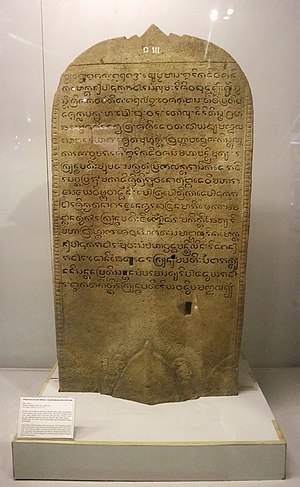
Summary
Gajah Mada inscription also known as Singhasari inscription, is an inscription written in old Javanese script, dated to 1273 Saka or corresponds to 1351 CE from Majapahit period, discovered in Singosari district, Malang Regency, East Java. The inscription is now preserved in National Museum of Indonesia in Jakarta under inventory number D 111.[1][2] The inscription was carved on a smooth surface, and the letters are clearly legible.[1]
| Gajah Mada inscription | |
|---|---|
 Gajah Mada inscription, dated 1273 Saka (1351 CE), discovered in Singosari, Malang, East Java. Mentioned about a sacred caitya building dedicated by Gajah Mada for the late King Kertanegara of Singhasari. | |
| Material | Stone |
| Created | 14th century[1] |
| Discovered | Singosari, Malang, East Java, Indonesia |
| Present location | National Museum of Indonesia, Jakarta |
| Registration | D 111 |
This inscription mentions Mpu Mada, the famed mahapatih (prime minister) of the 14th century Majapahit kingdom. Historians suggests the mahapatih himself commissioned this inscription — a political authority typically reserved only for the monarch (kings and queens). This indicates the importance of Gajah Mada's position within the kingdom that even has the right to issue his own inscription. Therefore, this inscription is called the Gajah Mada inscription.[1]
Content edit
This inscription was written to commemorate the construction of a funerary caitya or burial temple dedicated to King Kertanegara of Singhasari that died in 1214 Saka or 1292 CE, carried out by Mahapatih Gajah Mada.[3] The first half of this inscription described a very detailed date, including the astronomical position of the celestial bodies. The second half suggests the purpose of this inscription, which is as a construction of a caitya. The temple mentioned in this inscription most possibly refer to the syncretic Shivaist-Buddhist Singhasari temple, since this inscription was discovered near this temple.[3]
Transcription edit
- / 0 / 'i śaka ; 1214 ; jyeṣṭa māsa ; 'irika diwaśani
- kamoktan. pāduka bhaṭāra sang lumah ring śiwa buddha /’ ; /’ swa-
- sti śri śaka warṣatita ; 1273 ; weśaka māsa tithi pratipā-
- # da śuklapakṣa ; ha ; po ; bu ; wara ; tolu ; niri tistha graha-
- cara ; mṛga śira nakṣatra ; śaśi dewata ; bāyabya maṇḍala ;
- sobhanayoga ; śweta muhurtta ; brahmāparwweśa ; kistughna ;
- kāraṇa wṛṣabharaśi ; ‘irika diwaśa sang mahāmantri mūkya ; ra-
- kryan mapatih mpu mada ; sākṣat. praṇala kta rāsika de bhaṭā-
- ra sapta prabhu ; makādi śri tribhuwanotungga dewi mahārā
- jasa jayawiṣṇuwārddhani ; potra-potrikā de pāduka bha-
- ṭāra śri kṛtanāgara jñaneśwara bajra nāmābhiṣaka sama-
- ngkāna twĕk. rakryan mapatih jirṇnodhara ; makirtti caitya ri
- mahābrāhmāṇa ; śewa sogata samāñjalu ri kamokta-
- n pāduka bhaṭāra ; muwah sang mahāwṛddha mantri linā ri dagan
- bhaṭāra ; doning caitya de rakryan. mapatih pangabhaktya-
- nani santana pratisantana sang parama satya ri pāda dwaya bhaṭā-
- ra ; ‘ika ta kirtti rakryan mapatih ri yawadwipa maṇḍala /’[2]
References edit
- ^ a b c d "Prasasti Gajah Mada, Virtual Tour Museum Nasional Indonesia". museumnasional.iheritage-virtual.id. Retrieved 2023-02-01.
- ^ a b Ngalam.id. "Prasasti Singhasari (Gajah Mada)". ngalam.id (in Indonesian). Retrieved 2019-01-09.
- ^ a b "Siapa Sebenarnya Kakek Gajah Mada?". Historia - Obrolan Perempuan Urban (in Indonesian). Retrieved 2019-01-08.


